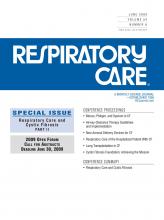Abstract
Cystic fibrosis (CF) patients use several therapies to treat chronic inflammation and infection in the lungs and to improve airway clearance. Inhaled therapies in CF typically include bronchodilators, airway wetting agents, mucus-active agents, and antibiotics, among others. There are many variables to take into account when prescribing aerosolized therapies to CF patients, including aerosol factors, patient variables (eg, age, disease severity, and breathing patterns), and the limitations of current aerosol delivery systems. The greatest challenge for patients is dealing with the time burden placed on them to try to fit all the treatments into their day—a burden that is likely to be even greater in the near future due to the exciting pipeline of novel therapies that target the genetic defect of CF as well as the pathophysiologic consequences. Fortunately, novel aerosol delivery systems and drug formulations are being developed to tackle the many challenges of aerosol delivery in CF. If successful, these systems will reduce the time burden and improve the clinical outcomes for the CF community.
- cystic fibrosis
- aerosol delivery
- slow mist device
- vibrating mesh
- breath-control nebulizers
- dry-powder inhaler
Footnotes
- Correspondence: Kenneth C Kesser RRT, Aerosol Research Laboratory, Nemours Children's Clinic, 496 S Delaney Avenue, Suite 406A, Orlando FL 33801. E-mail: bkesser{at}nemours.org.
Mr Kesser presented a version of this paper at the 43rd Respiratory Care Journal Conference, “Respiratory Care and Cystic Fibrosis,” held September 26-28, 2008, in Scottsdale, Arizona.
- Copyright © 2009 by Daedalus Enterprises Inc.







